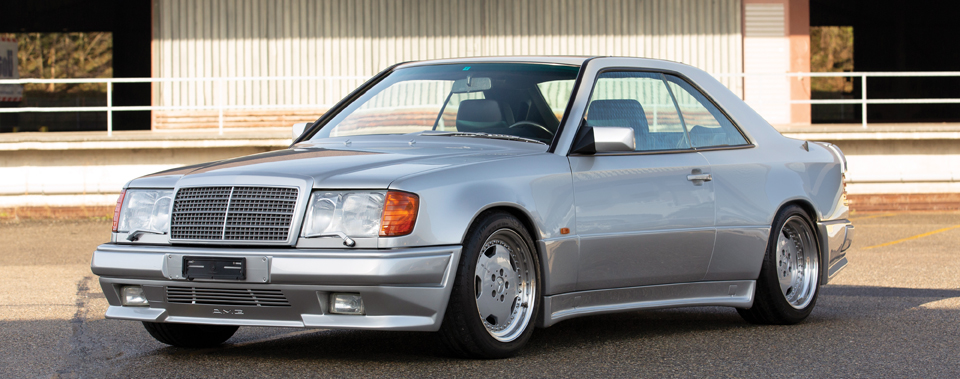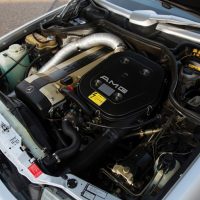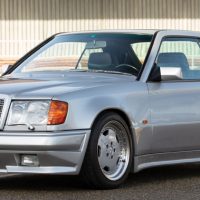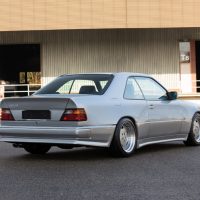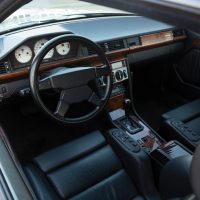SCM Analysis
Detailing
| Vehicle: | 1991 Mercedes-Benz 300CE AMG 3.4 |
| Years Produced: | 1988–93 |
| Number Produced: | Fewer than 50 |
| SCM Valuation: | $195,591 |
| Tune Up Cost: | $770, including all ignition parts and air filter |
| Chassis Number Location: | Stamped into radiator core support |
| Engine Number Location: | Front right area of engine block, behind alternator bracket |
| Club Info: | Mercedes Benz Club of America |
| Website: | http://www.MBCA.org |
| Alternatives: | 1988–95 BMW M5, 1991–95 Porsche 968, 1991–95 Lexus SC400 |
| Investment Grade: | A |
This car, Lot 188, sold for $124,229, including buyer’s premium, at RM Sotheby’s Paris, France, auction on February 5, 2020.
Another exotic offering from RM Sotheby’s Youngtimer Collection, this unusual W124 variant does a fantastic job bridging the gap between the raw 1980s AMG hot rods and the more refined off-the-shelf 1990s cars that were built with increasing levels of involvement from Mercedes.
Mercedes-Benz — the ultimate Japanese luxury car
If you’ve been following SCM’s recent AMG market analyses, you will find that all of our previous AMG subject cars have had a stint where they spent time in Japan — often re-emerging with modifications not seen anywhere else in the world.
It seems as if the Japanese market was creating AMGs that no one else had the imagination or the vision to create. And now, in the second decade of the 21st century, these amazing cars are suddenly beginning to appear on the world market.
Mercedes-Benz cars are highly revered in Japan. A USA Today poll showed that the majority of Japanese drivers consider Mercedes-Benz the most desirable automobile. Top-ranking members of the Yakuza have always favored Mercedes S-class over anything else. Even today, a black or white Mercedes S-class pushing through traffic in Tokyo must be given a clear path.
A mystery character in the hit manga series “Initial D” drives a Mercedes as well — female heroine Natsuki Mogi’s sugar daddy, who makes repeat appearances, but is primarily characterized by the car itself.
With a cultural emphasis on improvement and creating the best of the best, it’s no surprise that Japanese AMGs ended up taking on a life of their own.
A more usable AMG hot rod?
Japanese engineering has long venerated the inline 6, a concept that was masterfully integrated into cars such as the Toyota Supra, Datsun 280Z and Toyota 2000GT.
Mercedes also embraced this engine architecture well into the late 1990s, with the venerable M130 (used in the 280SE and 280SL), the M110 (used in all Mercedes product lines except for the W201 from 1972 to 1985), the M103, which powered the venerable 300E, and finally, this engine: the M104, which went on to power cars such as the C36.
Early KE-Jetronic M104 engines from 1990 to 1992 were completely different from the 3.2-liter engines used in the 320E, 320S and 320SL.
These M104 engines were an ingenious adaptation of an M103 block with a twin-cam, 4-valve head. It was only used in U.S. cars from 1990 to ’92 — in the 300SL and 300CE. Because it was only used for three years, it was never fully understood by even the best Mercedes technicians.
Regardless, this early M104, which avoided wiring-harness issues, continues to be a reliable and exciting Mercedes power unit. Our subject car shows that this engine had some real potential with just a few minor improvements. And most importantly, it was a well-developed, reliable engine, capable of running well without needing much more than a valve job at 100k miles.
How to make your own 300CE AMG
Depending on when it was built, it’s very likely that this engine shares some internals with what eventually became the C36 engine (M104.941). The auction catalog mentions a pair of special camshafts, which are similar to the ones used in the E36 and C36. In fact, today, if one wanted to put a home-built AMG powerplant together for their own 300CE, a C36 block, camshafts and exhaust manifold would likely yield an even better result than the one listed here, thanks to the extra displacement.
The main advantage of our subject car is that it still uses KE-Jetronic injection. While this system has an electronic control unit, the engine will still run reasonably well in the event of a major electrical problem. This is the miracle of KE-Jetronic.
Another advantage of this system is that it makes more power — albeit only slightly — than the HFM-SFI system that replaced it. While not immediately apparent in the M104, the best example is the early M199.960 used only in the 1990–92 500SL. This engine was rated around 322 horsepower, but as the M119 timeline moved forward, most versions developed 315 hp, until 1996, when output was dramatically improved by raising the compression.
The bottom end of our subject car’s engine is likely similar to the 3.4-liter M103 that AMG introduced circa 1986–87 as an improvement over the original 3-liter variant. This engine made 245 hp, which is impressive for an SOHC engine that originally made 188 hp.
I’m going to make a shameless plug here for the longevity of internal-combustion engines. If anyone ever converted this car to electric power, it would render the entire package boring and, arguably, worthless. At least 60% of the money plopped down for our subject car was done so because of what lives under the hood.
A treasure hunt for the enthusiast
The availability of exotic Mercedes in Japan is just starting to be fully understood.
Some great examples of these cars ended up in Japan — and are now starting to be offered for sale. The status of these cars ensured that many were well preserved, and many of them are reasonably priced. Of course, shipping costs negate some purchase savings, but the possibility of finding amazing cars hidden in Tokyo still exists.
The majority of AMG-Mercedes from this era are on the rise. While we don’t know where the top of this market is, this sale is evidence that true AMGs — examples with significant engine, interior and cosmetic enhancements — are seriously collectible. This car was fairly bought and sold in today’s market, and will likely never be cheaper. ♦
